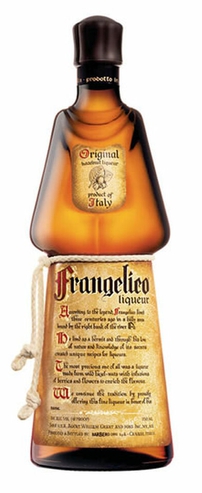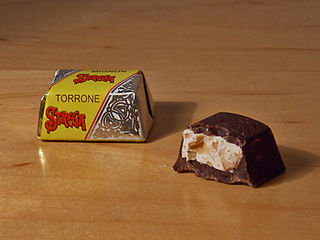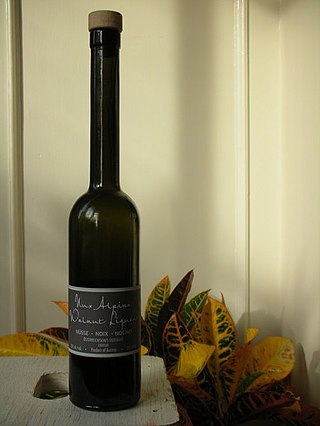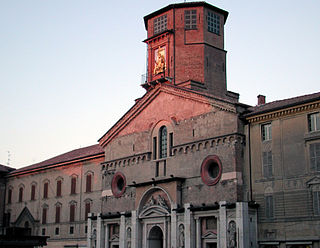Nocello is a walnut flavored liqueur from Italy. [1] It is produced by the Toschi Vignola S.r.l. company [1] of Savignano sul Panaro, province of Modena, Emilia-Romagna, Italy. The product originated in Emilia-Romagna. [1] It is labeled "Imitation Liqueur" in the United States and is 24% alcohol by volume. The liqueur is sweet with a rounded and balanced walnut flavour with vanilla tones. Nocello is similar in taste to Frangelico. In 2004 Nocello was awarded a gold medal at the IWSC (International Wine and Spirit Competition, UK) competition for nut liquors. Similar liqueurs have "been produced since medieval times and used as medicine". [1]

Emilia-Romagna is an administrative region of northern Italy, comprising the historical regions of Emilia and Romagna. Its capital is Bologna. It has an area of 22,446 km2 (8,666 sq mi), and a population of 4.4 million.

Caffè corretto is an Italian caffeinated alcoholic drink, consisting of a shot of espresso with a small amount of liquor, usually grappa, and sometimes sambuca or brandy. It is also known as an espresso corretto. It is ordered as un caffè corretto alla grappa, ... alla sambuca, ... al cognac, or corretto di Spadino, depending on the desired liquor.

Disaronno Originale is a type of amaretto—an amber-colored liqueur with a characteristic almond taste, although it does not actually contain almonds. It is produced in Saronno, in the Lombardy region of Italy, and is sold worldwide. According to the company, the liqueur is an infusion of apricot kernel oil with "absolute alcohol, burnt sugar, and the pure essence of seventeen selected herbs and fruits". The liqueur is sold in an oblong glass decanter designed by a craftsman from Murano.

Frangelico is a brand of noisette and herb-flavored liqueur coloured with caramel coloring, which is produced in Canale, Italy. It is 20% alcohol by volume (ABV) or 40 proof. Formerly, it was 24% ABV or 48 proof. When produced by the Barbaro family it was bottled at 28% ABV or 56 proof. The brand was created in 1978. It is known for its unusual packaging; its bottle was designed to look like a Christian friar, complete with a knotted white cord around the waist. It is most commonly sold in two sizes: 750ml and 375ml.

Aguardente (Portuguese), or aguardiente (Spanish), is a type of distilled alcoholic spirit that contains between 29% and 60% alcohol by volume (ABV). It is a somewhat generic term that can refer to liquors made from various foods. It originates from and is typically consumed on the Iberian Peninsula and in Iberian America.
Limoncello is an Italian lemon liqueur mainly produced in southern Italy, especially in the region around the Gulf of Naples, the Amalfi Coast, and Sicily. It is the second-most popular liqueur in Italy and is traditionally served chilled as an after-dinner digestivo. It is also a popular homemade liqueur, with various recipes available online and in print.

Alchermes is a type of Italian liqueur prepared by infusing neutral spirits with sugar, cinnamon, cloves, nutmeg, and vanilla, and other herbs and flavoring agents. Its most striking characteristic is its scarlet color, obtained by the addition of Kermes, a small scale insect from which the drink derives its name. Several proprietary variants are commercially available, where the coloring agent is a coal tar-derived dye such as E124 or E126, with alcoholic contents ranging from 21 to 32%. Its chief use is in coloring pastry, although a quick dessert is sometimes made by adding it to custard cream and sugar. In the Italian pudding zuppa inglese, sponge cake or ladyfingers soaked in this liqueur are a major ingredient.

Liquore Strega is an Italian herbal liqueur produced since 1860 by the Strega Alberti Benevento S.p.A. in Benevento, Italy. Its distinctive yellow color comes from the presence of saffron. Strega is bottled at 80 proof, which is an alcohol content comparable to most hard liquors, but it has a sweetness and viscosity typical of liqueurs. Among its approximately 70 herbal ingredients are mint and fennel, giving it a complex flavor with minty and coniferous notes.

Zuppa inglese is an Italian dessert layering custard and sponge cake, perhaps derived from trifle.

Nocino is a dark brown liqueur from the Emilia-Romagna region of Italy. It is made from unripe green walnuts. The walnuts and the liquor are handled using ceramic or wooden tools and placed in an alcoholic base. After steeping in spirit, the walnuts are removed and the alcohol is mixed with simple syrup. Nocino has an aromatic but bittersweet flavor. It may be homemade; villages and even individual families often have their own recipes, including different additions like cinnamon, juniper berries, lemon or orange zest, vanilla pods, coffee beans, or clove. The spices are added lightly, to avoid overpowering the flavour of the walnuts. A classic base consists of vodka. Nocino is also available commercially in bottled form. Commercially available nocino is typically 40 percent alcohol by volume, or 80 proof.

Amaro is an Italian herbal liqueur that is commonly consumed as an after-dinner digestif. It usually has a bitter-sweet flavour, sometimes syrupy, and has an alcohol content between 16% and 40%.

Reggio Emilia Cathedral is a Roman Catholic cathedral in Reggio Emilia. The dedication is to the Assumption of the Virgin Mary. Formerly the episcopal seat of the Diocese of Reggio Emilia, it has been since 1986 that of the Diocese of Reggio Emilia-Guastalla.

Piadina romagnola or simply piadina, traditionally piada, is a thin Italian flatbread, typically prepared in the Romagna historical region. It is usually made with white flour, lard or olive oil, salt and water. The dough was traditionally cooked on a terracotta dish, although nowadays flat pans or electric griddles are commonly used.

As San Marino is a microstate completely landlocked by Italy, Sammarinese cuisine is strongly similar to Italian cuisine, especially that of the adjoining Emilia-Romagna and Marche regions. San Marino's primary agricultural products are cheese, wine and livestock, and cheesemaking is a primary economic activity in San Marino. San Marino participated in The Exposition Universelle of 1889, a world's fair held in Paris, France, with three exhibits of oils and cheese.

Gruppo Sportivo Bagnolese Associazione Sportiva Dilettantistica is an Italian association football club located in Bagnolo in Piano, Emilia-Romagna. It currently plays in Serie D.
Rosolio is a type of Italian liqueur made from a base of alcohol, sugar, and water in the same proportion, which is flavored by adding an essence of any of various types.
The Palazzo Masdoni is a Baroque and Neoclassical-style palace located on Via Toschi #23 in the historic center of the town of Reggio Emilia in Italy. The palaces is notable for its quadratura or painted architecture in its two-story Sala di Musica or Music Room. From 1954 to 1991, it was the provincial office of the Italian Communist party. It rises across the street from the Istituto Omozzoli Parisetti.
The Palazzo Pratonieri is an eclectic monumental building, renovated in the 19th century using Gothic and Renaissance-style elements in the main facade, and interior decor influenced by Liberty style located on Via Toschi #9 in the historic center of the town of Reggio Emilia, region of Emilia Romagna, in Italy. It is owned by the banking enterprise Unicredit.